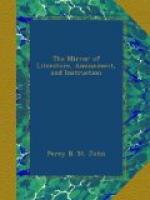On the 28th of February, 1606, Garnet was brought to trial at Guildhall, before nine Commissioners specially appointed for that purpose. Of his participation in the plot there was no doubt; and he admitted himself criminal in not revealing it, although, as he asserts, it was imparted to him only in confession: but it is more than probable that the valuable papers, lately rescued from oblivion, and preserved in his Majesty’s State Paper Office, will be able to prove his extensive connexion with the plot, his knowledge of it, both in and out of confession, and his influential character with all the conspirators.
Garnet was hanged on the 3rd of May, 1606, on a scaffold, erected for that purpose, at the west end of St. Paul’s Church. Held up to infamy by one party as a rebel and a traitor, and venerated as a saint and a martyr by the other; the same party spirit, and the same conflicting opinions, have descended from generation to generation, down to the controversialists of the present day.
We subjoin the Autographs of some of the principal conspirators, from the same source as the preceding narrative, as an appropriate and equally authentic accompaniment:—
Robert Catesbye.—Taken from an original letter from Catesbye to his cousin, John Grant, entreating him to provide money against a certain time. This autograph is very rare.
Guido Fawkes.—Taken from his declaration made in the Tower on the 19th of November, and afterwards acknowledged before the Lord’s Commissioners.
Thomas Percy.—From an original letter to W. Wycliff, Esq. of York, dated at Gainsborough, November 2nd, 1605.
Henry Garnet.—From one of his examinations, wherein he confessed to have been in pilgrimage to St. Winifred’s Well.
Ambrose Rookewood.—From an original letter, declared that he had felt a scruple of conscience, the fact seeming “too bluddy.”
Thomas Wintour.—From an original examination before the Lord’s Commissioners, on the 25th of November, 1605.
Francis Tresam.—From his examination relative to the book on Equivocation. Tresam escaped being hanged by dying in the Tower, on the 23rd of December, 1605.
Sir Everard Digby.—From an original examination. He was related to John Digby, subsequently created Baron Digby and Earl of Bristol, and was a young man of considerable talent. He was in the twenty-fourth year of his age when executed.
To the Right Hon. the Lord Mounteagle.—The superscription to the anonymous letter that led to the discovery of the plot. By whom it was written still remains a mystery.
All the principal conspirators were married and had families; several of them possessed considerable property, and were highly, and, in some instances, nobly related.
L.
* * * * *




